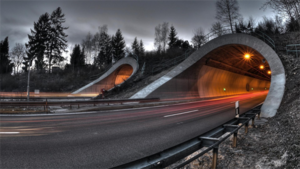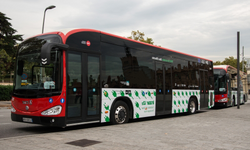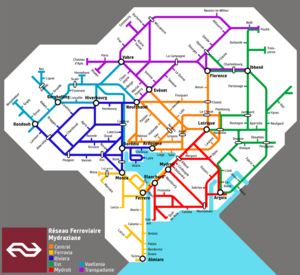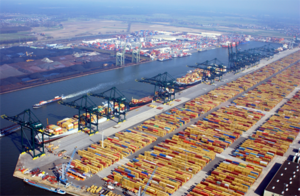Transport in Midrasia: Difference between revisions
m (1 revision imported) |
Revision as of 04:13, 16 March 2019
Transport in Midrasia is facilitated by road, air, rail and water networks. Inter-city and long distance travellers commonly utilise both road and rail for journeys; whilst most short distance passenger travel is reliant upon automobiles. Midrasia is renowned internationally for its railways, having the densest and busiest rail network in Aeia, allowing for rapid transportation between Midrasian cities or even to select destinations in bordering nations. Midrasian's drive on the left side of the road, as with most other Asuran nations. Midrasia has a hierarchical road system covering highways, arterial roads and paved roads across the majority of the country. Midrasia has a number of both regional and international airports, the most notable being Lotrič International Airport and Berghelling Erwann Berthou Airport which both rank as two of the busiest airports in Aeia. Midrasia also has a network of ports and waterways within the southern coastal regions.
Road transport
The road network in Midrasia is one of the most used in Asura, particularly for freight given the country's central location on the continent. With the country effectively taking the role of 'gatekeeper' of Asura for goods passing from Catai, the government was forced to introduce road tariffs on freight passing through Midrasia from outside of the Asuran Community at peak time in order to ease congestion and better maintain the road system. Midrasia's highway system carries the vast majority of inter-city traffic. The network, which was implemented in the 1940s covers most of the country. However it must be noted that the highway network covers much more of the urban south than the rural north, many locations within which can only be reached by smaller arterial or country roads.
Road travel remains the most popular form of transport in Midrasia, although usage has fallen in recent years. A minority of Midrasia's roads are toll roads, such as the Roebas Tunnel or A32 extension. The majority of toll roads were constructed between 1975 and 1990 by private companies on behalf of the government to deal with issues of rising road congestion. Prior to the construction of the Roebas Tunnel in 1987, the Midrasian road network was not directly connected across the Mydran gulf between Mydroll and Lombardy. The tunnel, which is the single longest road tunnel in Aeia at 42.63 kilometres (26.49 miles) allows for the passage of road and rail traffic across the gulf, eliminating the requirement for a ferry service or diversion around the sea.
Driving is on the left, with the maximum speed being 130 kilometres per hour (80mph) on highways and a select number of other roads.
In recent years, the Midrasian government has acted to reduce pollution by placing a much greater emphasis on public transport and carpooling. Research has suggested that within the last two years car usage has begun to slowly decline.
Road Passenger transport
Buses
Local bus services are commonplace across the country, usually serving local parishes or individual cities. The vast majority of these services are run by private companies, however recent initiatives have allowed a select number of councils to run local services, as is the case across much of Vaellenia. Buses usually charge a flat rate per journey, however the government does provide a subsidy for select groups such as students, the disabled or the elderly. Most urban bus networks also operate a card top-up system which allow commuters to access buses without purchase of a ticket for each journey. A number of companies and local authorities have begun to outfit their bus fleets with electric buses in an attempt to reduce emissions. Businesses and councils which field 'zero-emissions' buses are given tax deductions by central government. Some local councils have plans to introduce self-driving buses for select areas in the future, provided the technology becomes viable.
Coaches
Coach transport systems are rare within Midrasia, with only a select few companies offering regular inter-city or cross country journeys. The vast majority of coach services within the country are reserved for special occasions or one off journeys. Despite this, coach travel tends to be somewhat cheaper than rail transport in some areas. However, long journey times and the wide coverage of the rail network means coach transport has never been especially popular in Midrasia.
Taxi
Local taxi companies and publicly licensed taxi services regularly operate within the more populated regions of Midrasia, particularly in cities. All taxi drivers are required to hold a special taxi permit to operate and must be extensively vetted beforehand. Taxi companies are usually split between private hire (minicab) and publicly licensed services. Private hire cabs have a tendency to be cheaper, however must be pre-booked. Several notable Midrasian entrepreneurs have expressed their interest in setting up entire fleets of self-driving taxis, provided the technology becomes viable within the future.
Air transport
Midrasia has approximately 489 airfields, around two-thirds of which are paved. The country also has around 15 heliports although public access to such facilities is restricted.
The largest airport in the country by passenger numbers is Lotrič International Airport, which also ranks as Aeia's sixth busiest airport and the busiest in Asura. The airport functions as the primary air transit hub for the city of Lotrič and surrounding regions. The airport features four runways, two of which are 4,200 m (13,780 feet) in length. The airport mostly receives international passengers, including connections for flights from Vestrim to Catai or Majula; however domestic flights also operate within the airport, although on an infrequent basis. The second largest airport within the country is Berghelling Erwann Berthou Airport, which receives most passengers bound for destinations in western Midrasia or bordering cities in eastern tir Lhaeraidd or northern Aquidneck. The airport features two runways and regularly charts flights across Aeia. The third largest airport is Almiaro International Airport which mostly serves as a flight hub for southern Midrasia.
Other notable airports within the metropolitan Midrasia include: Argois International Airport, Blanchard Airport, Bordeiu International Airport, Ibbeny International Airport and Vabre Airport.
Fontnouveau International Airport is the only notable airport in Midrasia's overseas territories, with most other regions, such as Saint Luix or the Mazarin Isles only being served by smaller airfields.
The flag carrier of Midrasia is MYD Air which is also the third largest airline in Aeia in terms of both passenger numbers and fleet size. Other large Midrasian airlines include Moineau, Corsair and Lombard Airways.
Rail transport
Midrasia has a very strong rail infrastructure, built up since the early days of the Industrial revolution. The first railway in Midrasia was built between the capital of Lotrič and Merport in 1832 to transfer goods from the port to the industrial factories of the Midrasian capital. Since then Midrasia's railways have expanded exponentially, with private entities undertaking considerable expansion of the network throughout the nineteenth century. The railway network was nationalised in 1933 by the Social Democrats after which the network underwent considerable decline, mostly as a result of the wider recession witnessed in Asura throughout the early twentieth century. Although central government invested a considerable sum of money into the maintenance and expansion of the railways, the network was eventually privatised under the Alydian Democrat government of 1973-1994. Since privatisation the rail network has continued to expand, particularly with the construction of the Relier High-Speed Network between 1980 and 2010. Calls have been made by many to re-nationalise the individual rail franchises due to a perceived fall in standards and rising rail fares, however the government has indicated that this is not on its agenda.
The Midrasian railway network track is maintained by Midrasian Rail a government owned company, however most rail enterprises are run as private franchises. The network is usually divided between Intercity transport, train lines in specified regions; Relier, the high-speed network running on independent tracks; Rapid Transit, city metro's and light rail, comprised of inner city tram and train networks.
Intercity rail
As of 1989 Midrasian intercity rail is broken up into a number of franchises, each of which is run by independent companies which bid to hold the running rights for a period of fifteen years. The only franchise not to be run by a private enterprise is Rail Vaellenia which is controlled and maintained by the Vaellenian devolved government. Each rail franchise operates in a specified area across the country, usually across several of Midrasia's regions. In total, there are seven rail franchises operating across Midrasia's ten regions:
- Central - Toussaint, Candare and Rhone. (orange)
- Ferrovia - Almiaro, Alto and Firenze. (yellow)
- Riviera - Acadie, Candare and Piemonte. (blue)
- Rail Est - Catougne, Ibbeny and Viure. (green)
- Rail Mydroll - Mydroll, Catougne. (red)
- Rail Vaellenia - Vaellenia and Aven. (light blue)
- Transpadanie - Avadin, Elsouf, Lorient and Padania. (purple)
Relier
Main Article: Relier
Relier is Midrasia's high-speed rail service, operated by Midrasia Rail on behalf of the government. Plans for the network were drawn as early as 1972, however construction on the project was sporadic and the Relier did not begin operation until 1995. Currently the Relier runs between most of Midrasia's major cities. Currently Relier lines run between the cities of Lotrič, Almiaro, Monza, Ferero, Blanchard, Mydroll, Ibbeny, Bordeiu, Ardougne, Neufchatel, Berghelling, Florence and Vabre. Construction is currently underway on a line extension from Lotrič to Argois. Relier links are also available between Midrasia and other major cities within bordering nations, such as Wroslak, Oserland; Cyningburgh, Newrey and Pale, Aquidneck.
Trains on the Relier network regularly reach speeds of around 320 km/h (200mph) which is among the fastest for wheeled trains in Aeia. The network regularly carries around 100 million passengers each year, allowing the network to remain commercially viable and even gain profits of over Đ1 billion, as was recorded in 2009.
Plans have been submitted for the introduction of Maglev lines onto the Relier network. The introduction of Maglev trains onto the network could see train speeds more than double. However, such plans have been dropped due to concerns about the cost and commercial viability of the project, which would be a multi-trillion ducat project. Alternative, more realistic alternatives regarding Maglev have been considered, such as the construction of a small Maglev line across the Mydran gulf, between Blanchard and Ferero. However, such plans are in the very early stages of development.
Rapid transit
A number of cities within Midrasia have rapid transit systems. The busiest being the Lotrič Metro, one of the oldest and busiest underground systems in Aeia, averaging around 1.5 billion passengers every year. Construction on the metro began within the mid-nineteenth century by several private railway companies. It wasn't until nationalisation in 1933 that the network truly became unified under the Lotrič city council. The Lotrič Metro also includes overground tracks and a number of light rail additions which were added to the system in the late twentieth century. The expansion of the system has allowed it to cover the vast majority of the city and surrounding districts, even reaching as far as the towns of Roixs and Santonge. Other cities with rapid transit systems include Berghelling and Bordeiu, however the systems within these cities are much smaller than that present within the capital.
Light rail
A number of cities within Midrasia also make use of a light rail system, the most notable being Almiaro renowned for its expansive tram network. No other city within Midrasia has a network as large as that present within Almiaro, however smaller systems are still utilised in areas of Mydroll and the Docklands region of Lotrič. Although many other cities across the country originally made use of tram networks, particularly in the late nineteenth century; many of these systems have been dismantled due to rising car ownership in recent years.
Water transport
Water transport in Midrasia is largely only used for freight, although a small number of passenger services do exist. All water transport within the country is limited to the Southern coastal regions and a select number of navigable waterways across the remainder of the country. Midrasia has a number of major seaports on its southern coast including Argois, Almiaro, Blanchard, Montlebain, Estport and Ardougne. Around 48% of all imports enter Midrasia by the sea. A large number of Midrasian ports also provide access to cruise ships. Cruises from Midrasia regularly travel to nations throughout Asura and even as far as Majula or eastern Rennekka.
Southern Midrasia is also home to several canals, the majority of which are leftovers from the early Industrial revolution and as such are rarely used for freight in the present day. Despite this, canals in Midrasia are regularly used by tourists and boating enthusiasts. Canals are also a significant feature in a number of Midrasian towns and cities along the southern coast including Ardougne and Laterna.
Merchant marine
Throughout the nineteenth century and early twentieth century the Midrasian merchant marine was one of the largest in Aeia. Despite a decline in recent years, in combination with passage of the Shipping Act of 1941, the Midrasian merchant marine still holds a considerable size; where other nations have seen a reduction in the size of their merchant fleets due to the use of flags of convenience. The Midrasian merchant marine boasts a fleet of around 452 vessels of 1,000 gross register tons or over.
Ferry services
A small number of ferry services operate on the Midrasian mainland, mostly within the Mydran Gulf. Due to infrastructural improvements in recent years however, ferry services have seen considerable decline as a mode of transport across the country. Despite this, ferry services are still regularly used in some of Midrasia's overseas territories, particularly on the islands of Saint Luix and the Mazarin Isles.
Regular ferry services in metropolitan Midrasia include:







